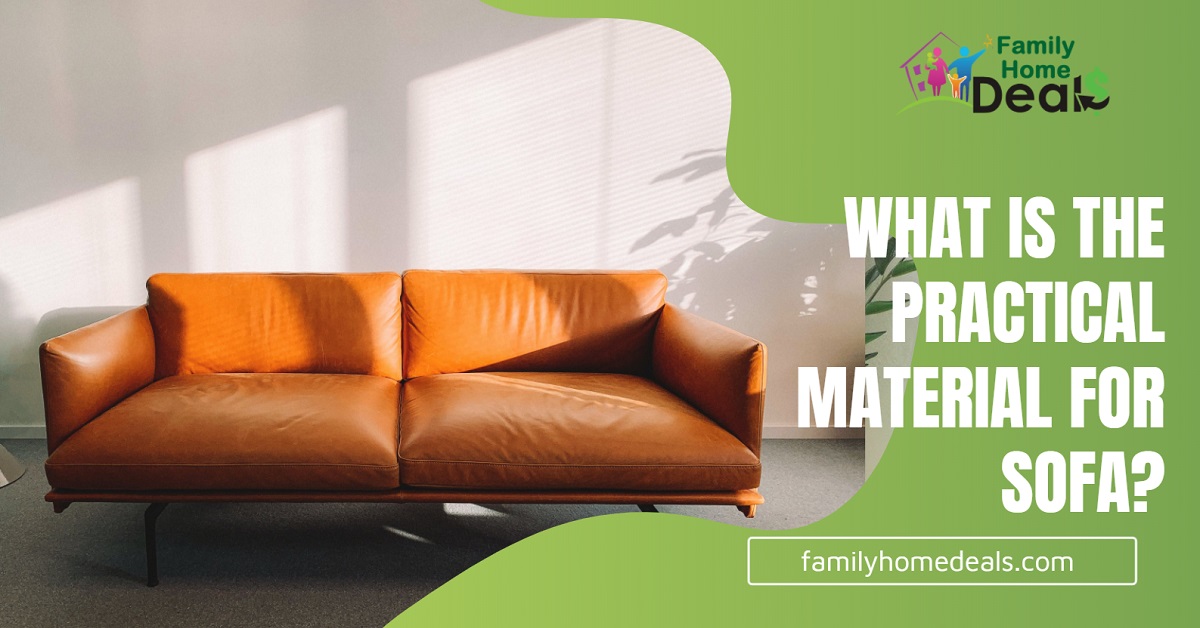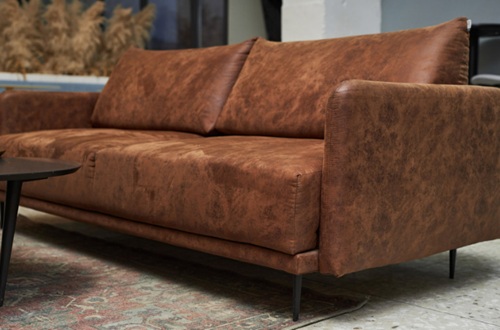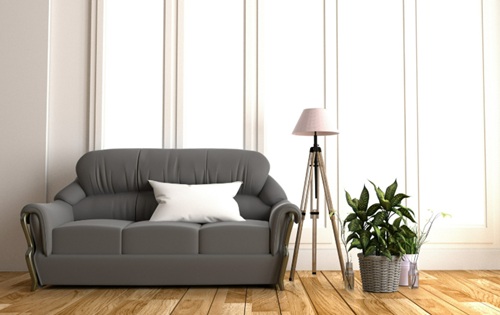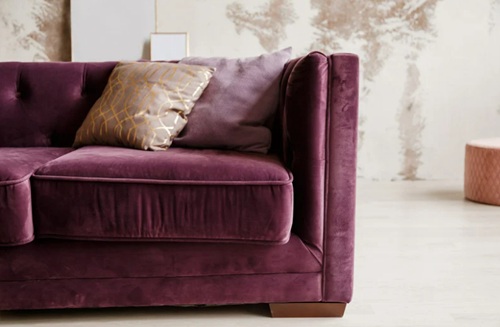
Choosing the perfect and practical material for sofa or couch isn’t just about appearances—it’s about comfort, lifestyle compatibility, maintenance, durability, and even health. Whether you’re furnishing your first apartment, redecorating your dream home, or simply updating your living room, one major decision will shape your experience for years: What is the most practical material for sofa?
With so many materials available today—from natural fabrics and synthetic options to luxe leathers and eco-conscious choices—the selection can feel overwhelming. Each comes with its unique perks and pitfalls, and finding the ideal fit depends on your lifestyle, taste, and budget. This guide will break down the most common sofa materials in 2025, highlight their pros and cons, and give you the insight you need to make a smart, stylish, and sustainable choice.
Why the Practical Material for Sofa Matters More Than Ever
In 2025, we’re spending more time than ever at home. Whether it’s hosting friends, cuddling up for movie nights, or working remotely, the sofa has become a multifunctional hub in our daily lives. The right material doesn’t just elevate your interior aesthetic—it ensures long-term comfort, easy upkeep, and even improved indoor air quality.
Let’s dive into the top sofa material options on the market today and explore which is the most practical for your home and lifestyle.
1. Natural Fabric Sofas: Timeless, Comfortable, and Budget-Friendly
Key materials: Cotton, linen, wool blends
Why choose it: Natural fabric sofas are a go-to option for those who value breathability, softness, and classic charm. Most commonly made from cotton or cotton blends, these sofas are typically lightweight, come in a huge range of colors and patterns, and offer a cozy, inviting texture.

Advantages:
- Affordability: Natural fabric sofas are often more budget-friendly than leather or designer synthetics.
- Comfort: Cotton and wool provide a soft, breathable surface that’s warm in winter and cool in summer.
- Versatility: A vast palette of colors and prints makes it easy to match any interior style.
- Removable Covers: Many fabric sofas come with slipcovers, ideal for homes with pets or children.
- Eco-Friendliness: Natural fibers are biodegradable and renewable, making them a sustainable choice.
Disadvantages:
- Stain Susceptibility: Unprotected cotton can absorb stains easily. Look for stain-resistant treatments or apply a fabric protector.
- Wrinkling & Fading: Natural fabrics are prone to wrinkling and can fade under direct sunlight.
- Maintenance Needs: While removable covers are a plus, frequent washing can wear the fabric out over time.
- Pilling Risk: Some weaves may pill after extended use.
Best For:
- Families with kids (especially with treated or washable covers)
- Pet owners
- Eco-conscious buyers
- Budget decorators
Pro Tip: If you choose a cotton sofa, opt for a blend with a bit of polyester for added durability, or look for OEKO-TEX® certified options that ensure safer chemicals and better environmental standards.
2. Synthetic Fabric Sofas: High-Performance Meets Easy Living
Key materials: Polyester, acrylic, nylon, microfiber, faux suede, olefin
Why choose it: Synthetic fabrics have surged in popularity due to their durability, affordability, and low maintenance. Whether it’s stain-resistant microfiber or smooth faux suede, these materials are engineered to hold up in busy households.

Advantages:
- Durability: Engineered for longevity, synthetic fabrics resist wear, fading, and stretching.
- Stain Resistance: Many are treated to resist moisture and stains—great for kids and pets.
- Affordability: Generally cheaper than leather and more durable than some natural fabrics.
- Wide Range of Textures: Can mimic natural materials like suede or even leather.
- Allergen Friendly: Dense weaves reduce the buildup of dust and pet dander.
Disadvantages:
- Environmental Concerns: Many synthetics are petroleum-based, raising sustainability concerns.
- Heat Sensitivity: Synthetic fibers can feel hot in warm climates or stick to skin in humid conditions.
- Static Buildup: Some synthetics generate static electricity, which can attract lint and dust.
Best For:
- High-traffic homes
- Pet lovers (microfiber is often claw-resistant)
- Allergy sufferers
- Budget-savvy households
Noteworthy Update (2025): Recycled polyester and bio-based synthetics are becoming mainstream. Look for certified eco-friendly synthetics that offer the same durability with reduced environmental impact.
3. Leather Sofas: Luxurious, Durable, and Hypoallergenic
Key materials: Full-grain, top-grain, split-grain, bonded leather
Why choose it: Leather is timeless for a reason. It adds instant sophistication to any space, is easy to clean, and actually improves with age—if cared for properly.

Advantages:
- Long Lifespan: High-quality leather can last 15-20 years or more with proper care.
- Hypoallergenic: Unlike fabrics, leather doesn’t trap dust, pet dander, or allergens.
- Easy to Clean: Spills can often be wiped off with a damp cloth.
- Aging Gracefully: Leather develops a unique patina over time, adding character.
Disadvantages:
- Price: Good leather is expensive. Bonded leather (a cheaper alternative) lacks durability and can peel.
- Temperature Sensitivity: Leather can feel cold in winter and sticky in summer without climate control.
- Maintenance Needs: Requires occasional conditioning to prevent drying and cracking.
- Vulnerable to Scratches: Particularly from pets or sharp clothing (beware of denim friction!).
Best For:
- Allergy-prone households
- Elegant or minimalist interiors
- Long-term investments
- Homes without rambunctious pets or toddlers
2025 Tip: Leather alternatives like vegetable-tanned leather or lab-grown leather are making waves in the industry, offering sustainability and style in one.
4. Faux Leather (PU or PVC): Budget Luxe That Looks the Part
Why choose it: Faux leather gives you the look of leather without the hefty price tag. It’s also animal-free, which appeals to vegans and ethically conscious buyers.

Advantages:
- Cost-Effective: Much cheaper than real leather.
- Low Maintenance: Wipes clean easily—ideal for messy households.
- Vegan-Friendly: No animal products involved.
- Color Variety: Available in bold or custom hues not found in natural leather.
Disadvantages:
- Shorter Lifespan: Prone to peeling, cracking, and wear over time.
- Less Breathable: Doesn’t adjust to body temperature as naturally as real leather.
- Environmental Impact: Still petroleum-based, though new plant-based faux leathers are emerging.
Best For:
- Style on a budget
- Trendy rental spaces
- Vegan households
Latest Update: Pinatex (pineapple leather), mushroom-based leather, and apple skin leather are gaining traction as more sustainable faux alternatives. Keep an eye out for brands embracing these cutting-edge innovations.
5. Performance Fabrics: Engineered for Real Life
Key materials: Crypton, Sunbrella, Revolution Fabric
Why choose it: Performance fabrics are the superheroes of the sofa world. Designed to withstand spills, stains, sun damage, and everyday wear, they’re perfect for the busiest of households.

Advantages:
- Water and Stain Resistant: Engineered to handle just about anything.
- UV Resistant: Won’t fade, even in rooms flooded with sunlight.
- Kid & Pet Proof: Built tough for families with little ones or furry friends.
- Easy Cleaning: Many can be cleaned with just soap and water.
Disadvantages:
- Cost: Generally more expensive than basic synthetics or cotton.
- Texture: Some may feel a little less “soft” than natural fabrics, though this has improved in recent years.
Best For:
- Active families
- Homes with pets
- High-use furniture (like sectionals)
- Indoor-outdoor crossover furniture
2025 Recommendation: Crypton and Sunbrella have expanded their eco-lines, offering stain-resistant fabrics made with recycled materials. Look for certifications like GREENGUARD Gold or OEKO-TEX® for extra peace of mind.
6. Velvet and Plush Fabrics: Luxe Looks with a Soft Touch
Why choose it: Velvet, chenille, and other plush fabrics bring a dramatic, high-end look to your home. They’re soft, warm, and visually stunning—but require a bit more TLC.

Advantages:
- Elegant Aesthetic: Instantly elevates your space.
- Softness: Extremely comfortable to sit on.
- Color Depth: Rich, vibrant tones that catch the light beautifully.
Disadvantages:
- Maintenance: Attracts dust, pet hair, and can stain easily.
- Wear and Tear: Pile may crush or show marks with heavy use.
- Cleaning: Not always easy to spot-clean; steam cleaning may be needed.
Best For:
- Low-traffic areas (formal living rooms, lounges)
- Glamorous or vintage-style interiors
- Pet-free homes
Hot Trend: Recycled velvet blends are now available, combining sustainable innovation with luxurious appeal.
What’s the Most Practical Sofa Material for You?
When it comes to choosing the most practical material for a sofa, the answer ultimately depends on your unique needs, habits, and style preferences. Natural fabrics like cotton or linen are breathable and eco-friendly but may need extra care. Synthetic fabrics offer unbeatable durability and affordability but come with environmental trade-offs. Leather offers timeless luxury and hypoallergenic benefits, while faux leather provides a cruelty-free, budget-friendly option. Performance fabrics are rising stars, ideal for modern, fast-paced households.
If you’re a busy family with pets and kids, performance fabrics or microfiber may be your best bet. If you’re an allergy sufferer, genuine leather or tight-weave synthetics might suit you better. And if you’re going for pure visual appeal in a rarely-used room? Velvet or natural linen might just win your heart.
Final Thoughts: Invest in What Fits Your Lifestyle
A sofa isn’t just furniture—it’s an investment in your comfort, your aesthetic, and your everyday life. Don’t be swayed by looks alone. Consider cleaning needs, allergen impact, environmental footprint, and longevity. With today’s expanded range of materials, you don’t have to compromise between style and practicality. You can have both.
As you shop for your ideal sofa in 2025, remember: the best material is the one that fits your lifestyle like a glove—and looks good doing it.
Noise, an Indian leading brand for smart wearables and lifestyle electronics
Noise has established itself as a leading brand in India’s wearable tech market, reportedly achieving the position of the country’s number one smartwatch brand for 13 consecutive quarters and ranking third globally in the same category. Noise continues to focus on delivering affordable, fashionable, and value-for-money tech products aimed at the youth segment. For the latest products and exclusive discounts, visit gonoise.com today!







